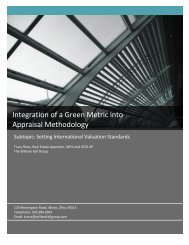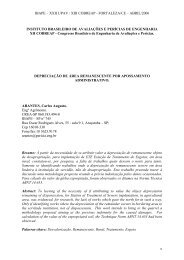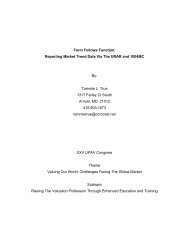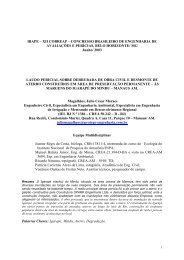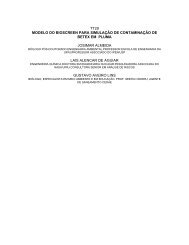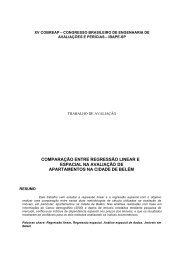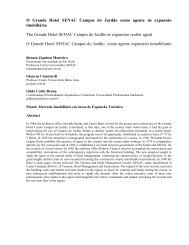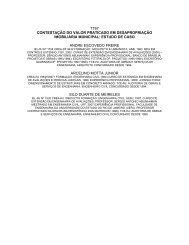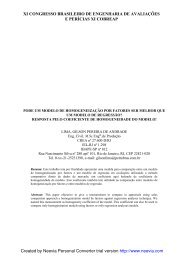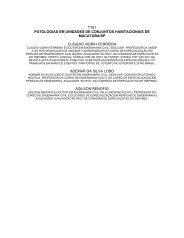Discounted Cash Flow Modeling in a Distressed Market - mrcl.com.br
Discounted Cash Flow Modeling in a Distressed Market - mrcl.com.br
Discounted Cash Flow Modeling in a Distressed Market - mrcl.com.br
Create successful ePaper yourself
Turn your PDF publications into a flip-book with our unique Google optimized e-Paper software.
<strong>Discounted</strong> <strong>Cash</strong> <strong>Flow</strong> <strong>Model<strong>in</strong>g</strong> <strong>in</strong> a <strong>Distressed</strong> <strong>Market</strong>:<<strong>br</strong> />
Investment Value vs. <strong>Market</strong> Value<<strong>br</strong> />
Mart<strong>in</strong> A. Skolnik, MAI<<strong>br</strong> />
5304 Reno Road, NW<<strong>br</strong> />
Wash<strong>in</strong>gton, DC 20015<<strong>br</strong> />
MSkolnik@realestate-consult<strong>in</strong>g.<strong>com</strong>
<strong>Discounted</strong> <strong>Cash</strong> <strong>Flow</strong> <strong>Model<strong>in</strong>g</strong> <strong>in</strong> a <strong>Distressed</strong> <strong>Market</strong>:<<strong>br</strong> />
Investment Value vs. <strong>Market</strong> Value<<strong>br</strong> />
Summary: Appraisers are taught early <strong>in</strong> their careers that there are<<strong>br</strong> />
differences and nuances between the different types/concepts of value such as<<strong>br</strong> />
<strong>in</strong>surable value, assessed value, <strong>in</strong>vestment value, use value, and market<<strong>br</strong> />
value. One area <strong>in</strong> which appraisal methodology has blurred the dist<strong>in</strong>ction<<strong>br</strong> />
between market value and <strong>in</strong>vestment value is <strong>in</strong> the valuation of <strong>in</strong><strong>com</strong>eproduc<strong>in</strong>g<<strong>br</strong> />
properties that have vacancy/absorption issues. This paper<<strong>br</strong> />
discusses the conceptual difference between market value and <strong>in</strong>vestment<<strong>br</strong> />
value for lease-up properties.<<strong>br</strong> />
The purpose of this paper is to demonstrate that a discounted cash flow (DCF)<<strong>br</strong> />
analysis that models the absorption of a partially leased <strong>in</strong><strong>com</strong>e-produc<strong>in</strong>g<<strong>br</strong> />
property 1 does not produce market value as most appraisers believe, but rather<<strong>br</strong> />
yields <strong>in</strong>vestment value.<<strong>br</strong> />
Although this is contrary to current appraisal practice, this conceptual change <strong>in</strong><<strong>br</strong> />
fundamental appraisal practice aligns the def<strong>in</strong>itions of both market value and<<strong>br</strong> />
<strong>in</strong>vestment value with the concept of the Pr<strong>in</strong>cipal of Anticipation. In this time of<<strong>br</strong> />
economic uncerta<strong>in</strong>ty, it is important for those <strong>in</strong>volved <strong>in</strong> real estate<<strong>br</strong> />
transactions such as primary lenders or the secondary mortgage market, to be<<strong>br</strong> />
provided with accurate representations of the true market value of a distressed<<strong>br</strong> />
property.<<strong>br</strong> />
For a property at stabilized operation, a properly documented discounted cash<<strong>br</strong> />
flow should produce an estimate of market value -- this discussion is not about those<<strong>br</strong> />
types of properties. The issue lies <strong>in</strong> the analysis of properties that do not exhibit<<strong>br</strong> />
stabilized operations (that is, properties that have material vacancy issues).<<strong>br</strong> />
Relevant def<strong>in</strong>itions used <strong>in</strong> this paper <strong>in</strong>clude:<<strong>br</strong> />
<strong>Market</strong> Value: The most probable sales price which a property should <strong>br</strong><strong>in</strong>g <strong>in</strong> a<<strong>br</strong> />
<strong>com</strong>petitive and open market under all conditions requisite to a fair sale, the buyer and<<strong>br</strong> />
seller, each act<strong>in</strong>g prudently, knowledgeably and assum<strong>in</strong>g the price is not affected by<<strong>br</strong> />
undue stimulus. Implicit <strong>in</strong> this def<strong>in</strong>ition is the consummation of a sale as of a specified<<strong>br</strong> />
date and the pass<strong>in</strong>g of title from seller to buyer under conditions whereby:<<strong>br</strong> />
1. Buyer and seller are typically motivated;<<strong>br</strong> />
1 Partial occupancy of a property might occur due to economic distress <strong>in</strong> the real estate market, or due to<<strong>br</strong> />
<strong>in</strong>itial lease-up, or to the vacat<strong>in</strong>g of a large tenant.<<strong>br</strong> />
Skolnik -- <strong>Discounted</strong> <strong>Cash</strong> <strong>Flow</strong> <strong>Model<strong>in</strong>g</strong> <strong>in</strong> a <strong>Distressed</strong> <strong>Market</strong> 1
2. Both parties are well <strong>in</strong>formed or advised, and each act<strong>in</strong>g <strong>in</strong> what he<<strong>br</strong> />
considers his own best <strong>in</strong>terest;<<strong>br</strong> />
3. A reasonable time is allowed for exposure <strong>in</strong> the open market;<<strong>br</strong> />
4. Payment is made <strong>in</strong> terms of cash <strong>in</strong> U.S. dollars or <strong>in</strong> terms of f<strong>in</strong>ancial<<strong>br</strong> />
arrangements <strong>com</strong>parable thereof; and<<strong>br</strong> />
5. The price represents the normal consideration for the property sold<<strong>br</strong> />
unaffected by special or creative f<strong>in</strong>anc<strong>in</strong>g or sales concessions granted by<<strong>br</strong> />
anyone associated with the sale. 2<<strong>br</strong> />
Investment Value: Investment value represents the value of a specific property to a<<strong>br</strong> />
particular <strong>in</strong>vestor. 3 Investment value is the price an <strong>in</strong>vestor would pay for an<<strong>br</strong> />
<strong>in</strong>vestment <strong>in</strong> light of its perceived capacity to satisfy that <strong>in</strong>dividual’s desires, needs,<<strong>br</strong> />
or <strong>in</strong>vestment goals. Criteria to evaluate a real estate <strong>in</strong>vestment are not necessarily<<strong>br</strong> />
set down by an <strong>in</strong>dividual <strong>in</strong>vestor; they may be established by an expert on real<<strong>br</strong> />
estate, i.e., an appraiser. 4 Investment value may co<strong>in</strong>cide with market value, if the<<strong>br</strong> />
client’s <strong>in</strong>vestment criteria are typical of successful buyers <strong>in</strong> the market. In this case,<<strong>br</strong> />
the two op<strong>in</strong>ions of value may be the same number, but the two types of value and<<strong>br</strong> />
their concepts are not <strong>in</strong>terchangeable. 5<<strong>br</strong> />
Background<<strong>br</strong> />
<strong>Discounted</strong> cash flow analysis (DCF) is a much-used analytical tool <strong>in</strong> the<<strong>br</strong> />
appraiser’s skill set, mostly applied to the valuation of multiple tenant <strong>in</strong><strong>com</strong>e-produc<strong>in</strong>g<<strong>br</strong> />
properties. It can be used either as a stand-alone valuation technique <strong>in</strong> the In<strong>com</strong>e<<strong>br</strong> />
Approach or it can be used <strong>in</strong> conjunction with a direct capitalization analysis. Buyers,<<strong>br</strong> />
sellers, developers, managers, and lenders of multiple tenant properties (retail,<<strong>br</strong> />
apartment, office, flex/warehouse, subdivision) use this analytical technique <strong>in</strong> their dayto-day<<strong>br</strong> />
due diligence and decision-mak<strong>in</strong>g processes. The appraisal <strong>com</strong>munity applies<<strong>br</strong> />
DCF analyses to try to mirror the methodologies and thought processes of the real<<strong>br</strong> />
estate <strong>com</strong>munity, and this is where the misconceptions between market value and<<strong>br</strong> />
<strong>in</strong>vestment value beg<strong>in</strong>.<<strong>br</strong> />
There are two primary uses of discounted cash flow analyses for distressed<<strong>br</strong> />
properties: 1) for appraisers and buyers to model the future <strong>in</strong><strong>com</strong>e potential of an<<strong>br</strong> />
2 OCC Regulation 12 CFR Part 34, Section 34.44.<<strong>br</strong> />
3 Appraisal Institute, The Appraisal of Real Estate, 13th ed. (Chicago: The Appraisal Institute, 2008), pages<<strong>br</strong> />
28-29<<strong>br</strong> />
4 Appraisal Institute, The Appraisal of Real Estate, 12th ed. (Chicago: The Appraisal Institute, 2001), pages<<strong>br</strong> />
26-27<<strong>br</strong> />
5 Op. Cit., page 450<<strong>br</strong> />
Skolnik -- <strong>Discounted</strong> <strong>Cash</strong> <strong>Flow</strong> <strong>Model<strong>in</strong>g</strong> <strong>in</strong> a <strong>Distressed</strong> <strong>Market</strong> 2
unstabilized property <strong>in</strong> an attempt to estimate its market value; and 2) for owners and<<strong>br</strong> />
asset managers to model the on-go<strong>in</strong>g operations of a property to ascerta<strong>in</strong> the value to<<strong>br</strong> />
the exist<strong>in</strong>g user. For a s<strong>in</strong>gle unstabilized property, there could be two <strong>com</strong>pletely<<strong>br</strong> />
different values derived from a DCF – one produced by the appraiser or buyer that<<strong>br</strong> />
represents the value <strong>in</strong> transfer (i.e., market value) and one produced by the owner or<<strong>br</strong> />
asset manager that represents the value <strong>in</strong> cont<strong>in</strong>ued use by that specific owner (i.e.,<<strong>br</strong> />
<strong>in</strong>vestment value).<<strong>br</strong> />
Have appraisers been call<strong>in</strong>g the results of their discounted cash flow analyses<<strong>br</strong> />
for properties with vacancy market value all these years when, <strong>in</strong> fact, it is <strong>in</strong>vestment<<strong>br</strong> />
value? As a buyer recently asked, “Why would I pay the seller for some mythical leaseup<<strong>br</strong> />
that they won’t even be <strong>in</strong>volved with? I will only pay the seller a price based on<<strong>br</strong> />
current occupancy, i.e., that which the seller has <strong>br</strong>ought to the table, and any lease-up<<strong>br</strong> />
that occurs because of my market<strong>in</strong>g abilities is profit that accrues to me. Why should<<strong>br</strong> />
your appraisal of market value be based on anyth<strong>in</strong>g but current <strong>in</strong><strong>com</strong>e?”<<strong>br</strong> />
The Pr<strong>in</strong>ciple of Anticipation, which is the cornerstone of the In<strong>com</strong>e Approach,<<strong>br</strong> />
states, “value is created by the anticipation of benefits to be derived <strong>in</strong> the future.” 6<<strong>br</strong> />
Further, “value is based on the market participants’ perceptions of the future benefits of<<strong>br</strong> />
acquisition.” In its def<strong>in</strong>ition of Anticipation, The Appraisal of Real Estate does not<<strong>br</strong> />
dist<strong>in</strong>guish between market value, <strong>in</strong>vestment value, or use value. Unfortunately, it is a<<strong>br</strong> />
well-entrenched misconception <strong>in</strong> the appraisal <strong>in</strong>dustry that the Pr<strong>in</strong>ciple of Anticipation<<strong>br</strong> />
implies that any future benefits accrue to yield market value. That is not true.<<strong>br</strong> />
Anticipated benefits can accrue to the buyer of a property, or to the seller, or to both.<<strong>br</strong> />
The current application of the discounted cash flow methodology <strong>in</strong> estimat<strong>in</strong>g<<strong>br</strong> />
market value for partially or wholly vacant properties erroneously allocates the entire<<strong>br</strong> />
future benefit of cash flow solely to the seller (i.e., current owner) and none to the buyer<<strong>br</strong> />
(i.e., the entity that creates the future cash flows). The future benefits of absorption are<<strong>br</strong> />
produced by the buyer and accrue to the buyer, not to the seller, so this should be<<strong>br</strong> />
6 Appraisal Institute, The Appraisal of Real Estate, 13th ed. (Chicago: The Appraisal Institute, 2008), p. 35.<<strong>br</strong> />
Skolnik -- <strong>Discounted</strong> <strong>Cash</strong> <strong>Flow</strong> <strong>Model<strong>in</strong>g</strong> <strong>in</strong> a <strong>Distressed</strong> <strong>Market</strong> 3
termed the buyer’s <strong>in</strong>vestment value not its market value. DCF models do not<<strong>br</strong> />
dist<strong>in</strong>guish between future <strong>in</strong><strong>com</strong>e from actual leases procured by the seller versus<<strong>br</strong> />
hypothetical <strong>in</strong><strong>com</strong>e that might be procured by the buyer <strong>in</strong> the future. In the DCF<<strong>br</strong> />
model, future <strong>in</strong><strong>com</strong>e from all leases is treated the same – as if it equally contributes to<<strong>br</strong> />
the market value of the property. This is not true. The difference between these two<<strong>br</strong> />
scenarios is the dist<strong>in</strong>ction between market value and <strong>in</strong>vestment value.<<strong>br</strong> />
Asset managers and owners use discounted cash flow analyses to model a<<strong>br</strong> />
property’s future operations and prospective leas<strong>in</strong>g of currently vacant space to<<strong>br</strong> />
understand a property’s potential cash flow, both before and after debt service. For<<strong>br</strong> />
them, the DCF provides a snapshot of net <strong>in</strong><strong>com</strong>e potential through their prospective<<strong>br</strong> />
hold<strong>in</strong>g period. It is the value that the owner, itself, creates over the hold<strong>in</strong>g period.<<strong>br</strong> />
The owner is not imply<strong>in</strong>g a transfer of the property on the date of value; the owner will<<strong>br</strong> />
cont<strong>in</strong>ue manag<strong>in</strong>g and market<strong>in</strong>g the property. The cash flow analysis represents its<<strong>br</strong> />
stewardship of the property.<<strong>br</strong> />
Appraisers, on the other hand, model the transactional value of the property.<<strong>br</strong> />
That is, appraisers (and lenders) should be <strong>in</strong>terested <strong>in</strong> the value of the property as-is.<<strong>br</strong> />
Leas<strong>in</strong>g of currently vacant space <strong>in</strong> a distressed property after the date of value is due<<strong>br</strong> />
to the buyer’s entrepreneurialism, not the seller’s. If a prudently and knowledgeable<<strong>br</strong> />
seller had been able to lease the vacant space, it would have done so prior to the<<strong>br</strong> />
valuation date. As such, the <strong>in</strong>cremental value of any leas<strong>in</strong>g after the valuation date<<strong>br</strong> />
should accrue to the buyer, not the seller. That is, any <strong>in</strong>cremental value (i.e., leas<strong>in</strong>g)<<strong>br</strong> />
after the date of value does not contribute to market value<<strong>br</strong> />
If the seller is not the procur<strong>in</strong>g cause of the future prospective tenants, the<<strong>br</strong> />
present value of this future cash flow should not be part of the price that the buyer pays<<strong>br</strong> />
the seller. <strong>Market</strong> value is value-<strong>in</strong>-exchange, so if a buyer is not pay<strong>in</strong>g for it, then it is<<strong>br</strong> />
not part of market value. Therefore, the result of a DCF that models certa<strong>in</strong>-term<<strong>br</strong> />
current leases along with <strong>in</strong><strong>com</strong>e result<strong>in</strong>g from prospective future leas<strong>in</strong>g procured by<<strong>br</strong> />
the buyer is actually <strong>in</strong>vestment value to the current owner. As mentioned above, this is<<strong>br</strong> />
Skolnik -- <strong>Discounted</strong> <strong>Cash</strong> <strong>Flow</strong> <strong>Model<strong>in</strong>g</strong> <strong>in</strong> a <strong>Distressed</strong> <strong>Market</strong> 4
the typical DCF model for asset managers and owners. However, <strong>in</strong> today’s appraisal<<strong>br</strong> />
practice, this is erroneously called market value. So, market value for a distressed,<<strong>br</strong> />
partially occupied property is the present worth of certa<strong>in</strong>-term leas<strong>in</strong>g, not from<<strong>br</strong> />
prospective leas<strong>in</strong>g that occurs <strong>in</strong> the future only due to the market<strong>in</strong>g and management<<strong>br</strong> />
efforts of the buyer.<<strong>br</strong> />
Valuation Scenario<<strong>br</strong> />
Assume a simple valuation scenario for demonstration purposes: the subject<<strong>br</strong> />
property is a 60,000 square foot office build<strong>in</strong>g with 40,000 square feet occupied at<<strong>br</strong> />
$16.00 per square foot with three vacant suites: 10,000 square feet, 7,000 square feet,<<strong>br</strong> />
and 3,000 square feet. The vacant 10,000 square foot suite is anticipated to be at the<<strong>br</strong> />
beg<strong>in</strong>n<strong>in</strong>g of the Quarter 3 of Year 1 of the analysis, the 7,000 square foot suite is<<strong>br</strong> />
anticipated to be leased at the beg<strong>in</strong>n<strong>in</strong>g of Quarter 1 <strong>in</strong> Year 2, and the 3,000 square<<strong>br</strong> />
foot suite is anticipated to be leased at the beg<strong>in</strong>n<strong>in</strong>g of Quarter 3 <strong>in</strong> Year 2. The simple<<strong>br</strong> />
assumptions for this analysis are listed <strong>in</strong> Table 1.<<strong>br</strong> />
Table 1<<strong>br</strong> />
Basic Valuation Assumptions<<strong>br</strong> />
<strong>Market</strong> rent $16.00<<strong>br</strong> />
Inflation 0%<<strong>br</strong> />
Rent <strong>in</strong>creases<<strong>br</strong> />
Fixed operat<strong>in</strong>g expenses<<strong>br</strong> />
Variable operat<strong>in</strong>g expenses<<strong>br</strong> />
Leas<strong>in</strong>g expenses<<strong>br</strong> />
Management fees<<strong>br</strong> />
None<<strong>br</strong> />
$3.00 per sq. foot<<strong>br</strong> />
20% of gross <strong>in</strong><strong>com</strong>e<<strong>br</strong> />
10% of first year’s rent<<strong>br</strong> />
5% of gross <strong>in</strong><strong>com</strong>e<<strong>br</strong> />
Current capitalization rate 6.0%<<strong>br</strong> />
Reversion capitalization rate 6.0%<<strong>br</strong> />
Internal Rate of Return (IRR) 7.5%<<strong>br</strong> />
The typical, current solution to this valuation problem for the appraiser is to<<strong>br</strong> />
develop a cash flow model and estimate the lease-up/absorption of the vacant space,<<strong>br</strong> />
and then discount the <strong>in</strong><strong>com</strong>e (net of operat<strong>in</strong>g expenses) to present value. Table 2 is<<strong>br</strong> />
an example of the cash flow model and it yields a cash flow value of $8,530,000,<<strong>br</strong> />
rounded.<<strong>br</strong> />
Skolnik -- <strong>Discounted</strong> <strong>Cash</strong> <strong>Flow</strong> <strong>Model<strong>in</strong>g</strong> <strong>in</strong> a <strong>Distressed</strong> <strong>Market</strong> 5
Table 2<<strong>br</strong> />
<strong>Discounted</strong> <strong>Cash</strong> <strong>Flow</strong> Model with Lease-Up of 33% Vacancy<<strong>br</strong> />
Currently labeled “market value” by the appraisal <strong>com</strong>munity<<strong>br</strong> />
Year 1 Year 2<<strong>br</strong> />
Quarter 1 Quarter 2 Quarter 3 Quarter 4 Quarter 1 Quarter 2 Quarter 3 Quarter 4<<strong>br</strong> />
In<strong>com</strong>e<<strong>br</strong> />
40,000 sf occupied $ 160,000 $ 160,000 $ 160,000 $ 160,000 $ 160,000 $ 160,000 $ 160,000 $ 160,000<<strong>br</strong> />
10,000 sf vacant 0 0 40,000 40,000 40,000 40,000 40,000 40,000<<strong>br</strong> />
7,000 sf vacant 0 0 0 0 28,000 28,000 28,000 28,000<<strong>br</strong> />
3,000 sf vacant 0 0 0 0 0 0 12,000 12,000<<strong>br</strong> />
Gross In<strong>com</strong>e $ 160,000 $ 160,000 $ 200,000 $ 200,000 $ 228,000 $ 228,000 $ 240,000 $ 240,000<<strong>br</strong> />
Expenses<<strong>br</strong> />
Fixed Expenses $ 3.00 $ 45,000 $ 45,000 $ 45,000 $ 45,000 $ 45,000 $ 45,000 $ 45,000 $ 45,000<<strong>br</strong> />
Variable Expenses 20% 32,000 32,000 40,000 40,000 45,600 45,600 48,000 48,000<<strong>br</strong> />
Leas<strong>in</strong>g Expenses 10% 0 0 16,000 0 11,200 0 4,800 0<<strong>br</strong> />
Management 5% 8,000 8,000 10,000 10,000 11,400 11,400 12,000 12,000<<strong>br</strong> />
Total Expenses $ 85,000 $ 85,000 $ 111,000 $ 95,000 $ 113,200 $ 102,000 $ 109,800 $ 105,000<<strong>br</strong> />
Net Operat<strong>in</strong>g In<strong>com</strong>e $ 75,000 $ 75,000 $ 89,000 $ 105,000 $ 114,800 $ 126,000 $ 130,200 $ 135,000<<strong>br</strong> />
Reversion Cap. Rate 6.0%<<strong>br</strong> />
$ 9,000,000<<strong>br</strong> />
Quarterly <strong>Cash</strong> <strong>Flow</strong> $ 75,000 $ 75,000 $ 89,000 $ 105,000 $ 114,800 $ 126,000 $ 130,200 $ 9,135,000<<strong>br</strong> />
Discount Rate 7.5%<<strong>br</strong> />
Total Value by DCF $ 8,530,000<<strong>br</strong> />
It is important to note that the lease-up of the currently vacant space over the<<strong>br</strong> />
absorption period (20,000 square feet <strong>in</strong> two years) is only go<strong>in</strong>g to occur due to the<<strong>br</strong> />
buyer’s market<strong>in</strong>g and management skills and, more importantly, it will occur dur<strong>in</strong>g the<<strong>br</strong> />
buyer’s ownership period. If the buyer is creat<strong>in</strong>g occupancy over the next two years,<<strong>br</strong> />
why would it reward the seller by pay<strong>in</strong>g the seller the <strong>in</strong>cremental value achieved by<<strong>br</strong> />
the buyer’s market<strong>in</strong>g/management efforts? What has the seller done to “earn” this<<strong>br</strong> />
<strong>in</strong>cremental amount <strong>in</strong> its market value estimate?<<strong>br</strong> />
Contrary to currently accepted appraisal practice, this $8,530,000 cash flow<<strong>br</strong> />
value does not represent market value; it is the property’s <strong>in</strong>vestment value. The<<strong>br</strong> />
prospective leas<strong>in</strong>g will be created by the buyer due to its ownership of, and its<<strong>br</strong> />
<strong>in</strong>vestment <strong>in</strong> market<strong>in</strong>g and management of, the property beg<strong>in</strong>n<strong>in</strong>g on Day 1 of the<<strong>br</strong> />
analysis (i.e., the ownership period of the buyer). It is the value that the buyer creates<<strong>br</strong> />
for itself; that is the essence of <strong>in</strong>vestment value.<<strong>br</strong> />
Skolnik -- <strong>Discounted</strong> <strong>Cash</strong> <strong>Flow</strong> <strong>Model<strong>in</strong>g</strong> <strong>in</strong> a <strong>Distressed</strong> <strong>Market</strong> 6
Even though the absorption estimate is market-based and could be achieved by<<strong>br</strong> />
a <strong>com</strong>petent ownership entity with the requisite management and market<strong>in</strong>g skills, it is<<strong>br</strong> />
not value that a seller/owner has achieved as of the date of value. It is value that the<<strong>br</strong> />
next owner would achieve if it owned the property on Day 1 of the analysis and would<<strong>br</strong> />
follow through on the market<strong>in</strong>g and management expectations of the market. The<<strong>br</strong> />
seller is not the owner of the property on Day 1 of the cash flow analysis; the buyer is.<<strong>br</strong> />
The buyer is the owner at the beg<strong>in</strong>n<strong>in</strong>g of the cash flow analysis and, as such, the<<strong>br</strong> />
<strong>in</strong>cremental value result<strong>in</strong>g from absorption and lease-up after Day 1 is the value to that<<strong>br</strong> />
particular buyer, i.e., <strong>in</strong>vestment value. The buyer’s <strong>in</strong>vestment value could, of course,<<strong>br</strong> />
be based on market assumptions of lease-up and absorption but that does not<<strong>br</strong> />
necessarily mean that the buyer’s value conclusion is market value (see previously<<strong>br</strong> />
presented def<strong>in</strong>ition of <strong>in</strong>vestment value).<<strong>br</strong> />
If the appraiser’s valuation scenario holds true, the buyer <strong>in</strong> this example would<<strong>br</strong> />
be pay<strong>in</strong>g the seller $8,530,000 for a 67% occupied property -- essentially giv<strong>in</strong>g the<<strong>br</strong> />
seller the present value of the net rental <strong>in</strong><strong>com</strong>e received dur<strong>in</strong>g the buyer’s ownership<<strong>br</strong> />
period due to the buyer’s market<strong>in</strong>g and management expertise. This is not a<<strong>br</strong> />
reasonable.<<strong>br</strong> />
Consider the difference between the lease-up scenario described above for the<<strong>br</strong> />
property at 67% occupancy that yielded an $8,530,000 value and a valuation example<<strong>br</strong> />
as if the same property is 100% leased at the time of the appraisal. At 100%<<strong>br</strong> />
occupancy, the value of the subject is $9,000,000 as shown <strong>in</strong> Table 3. This represents<<strong>br</strong> />
market value of the leased fee <strong>in</strong>terests at 100% occupancy.<<strong>br</strong> />
Skolnik -- <strong>Discounted</strong> <strong>Cash</strong> <strong>Flow</strong> <strong>Model<strong>in</strong>g</strong> <strong>in</strong> a <strong>Distressed</strong> <strong>Market</strong> 7
Table 3<<strong>br</strong> />
Valuation Example at 100% Occupancy<<strong>br</strong> />
100% Occupancy Valuation (Stabilized)<<strong>br</strong> />
Stabilized<<strong>br</strong> />
12-month <strong>Cash</strong> <strong>Flow</strong><<strong>br</strong> />
In<strong>com</strong>e<<strong>br</strong> />
40,000 sf occupied $ 640,000<<strong>br</strong> />
10,000 sf vacant 160,000<<strong>br</strong> />
7,000 sf vacant 112,000<<strong>br</strong> />
3,000 sf vacant 48,000<<strong>br</strong> />
Gross In<strong>com</strong>e $ 960,000<<strong>br</strong> />
Expenses<<strong>br</strong> />
Fixed Expenses $ 3.00 $ 180,000<<strong>br</strong> />
Variable Expenses 20% 192,000<<strong>br</strong> />
Leas<strong>in</strong>g Expenses 10% 0<<strong>br</strong> />
Management 5% 48,000<<strong>br</strong> />
Total Expenses $ 420,000<<strong>br</strong> />
Net Operat<strong>in</strong>g In<strong>com</strong>e $ 540,000<<strong>br</strong> />
Capitalization Rate 6.0%<<strong>br</strong> />
Indicated <strong>Market</strong> Value $ 9,000,000<<strong>br</strong> />
The difference <strong>in</strong> value for the subject between 100% occupancy ($9,000,000)<<strong>br</strong> />
and 67% occupancy with a two-year lease up ($8,530,000) is only $460,000. That is, <strong>in</strong><<strong>br</strong> />
the traditional DCF analysis that is currently erroneously called market value, the<<strong>br</strong> />
ownership risk of 33% vacancy translates to only a 5% reduction <strong>in</strong> value. Does this<<strong>br</strong> />
seem reasonable? No.<<strong>br</strong> />
Consider the as-is valuation scenario outl<strong>in</strong>ed <strong>in</strong> Table 4. Assume that market<<strong>br</strong> />
value for the subject is based solely on the leas<strong>in</strong>g currently <strong>in</strong>-place at the subject as of<<strong>br</strong> />
the valuation date, all other assumptions be<strong>in</strong>g equal to the valuation scenarios outl<strong>in</strong>ed<<strong>br</strong> />
<strong>in</strong> Tables 2 and 3. That is, the <strong>in</strong>cremental value of any leas<strong>in</strong>g after the valuation date<<strong>br</strong> />
would accrue to the buyer, not the seller, and are not part of the value that the buyer<<strong>br</strong> />
would pay the seller for the property. The valuation would result <strong>in</strong> a $5,000,000 value,<<strong>br</strong> />
rounded. (Note: In addition to the base $5,000,000 value, there might be some<<strong>br</strong> />
<strong>in</strong>cremental contributory value for exist<strong>in</strong>g office space f<strong>in</strong>ish, build<strong>in</strong>g “reputation”, and<<strong>br</strong> />
the like. The enumeration of this <strong>in</strong>cremental contributory value is beyond the scope of<<strong>br</strong> />
Skolnik -- <strong>Discounted</strong> <strong>Cash</strong> <strong>Flow</strong> <strong>Model<strong>in</strong>g</strong> <strong>in</strong> a <strong>Distressed</strong> <strong>Market</strong> 8
this paper, but the appraiser should determ<strong>in</strong>e if such <strong>in</strong>cremental value exists <strong>in</strong> the<<strong>br</strong> />
subject property.)<<strong>br</strong> />
Table 4<<strong>br</strong> />
Valuation As-Is at 67% Occupancy<<strong>br</strong> />
<strong>Distressed</strong> Occupancy<<strong>br</strong> />
Valuation Capitaliz<strong>in</strong>g Certa<strong>in</strong> Term In<strong>com</strong>e<<strong>br</strong> />
12-month <strong>Cash</strong> <strong>Flow</strong><<strong>br</strong> />
In<strong>com</strong>e<<strong>br</strong> />
40,000 sf occupied $ 640,000<<strong>br</strong> />
10,000 sf vacant 0<<strong>br</strong> />
7,000 sf vacant 0<<strong>br</strong> />
3,000 sf vacant 0<<strong>br</strong> />
Gross In<strong>com</strong>e $ 640,000<<strong>br</strong> />
Expenses<<strong>br</strong> />
Fixed Expenses $ 3.00 $ 180,000<<strong>br</strong> />
Variable Expenses 20% 128,000<<strong>br</strong> />
Leas<strong>in</strong>g Expenses 10% 0<<strong>br</strong> />
Management 5% 32,000<<strong>br</strong> />
Total Expenses $ 340,000<<strong>br</strong> />
Net Operat<strong>in</strong>g In<strong>com</strong>e $ 300,000<<strong>br</strong> />
Capitalization Rate 6.0%<<strong>br</strong> />
Indicated <strong>Market</strong> Value $ 5,000,000<<strong>br</strong> />
In this as-is example, the seller has only achieved 67% occupancy. Why would a<<strong>br</strong> />
prudent and knowledgeable buyer pay the seller more than the value of the property asis<<strong>br</strong> />
for its current cash flow?<<strong>br</strong> />
The key to determ<strong>in</strong><strong>in</strong>g if these scenarios are really <strong>in</strong>vestment value or market<<strong>br</strong> />
value can be found <strong>in</strong> the most widely accepted def<strong>in</strong>ition of market value for<<strong>br</strong> />
transaction purposes, previously presented. The important phrases <strong>in</strong> this def<strong>in</strong>ition<<strong>br</strong> />
are: “the buyer and seller each act<strong>in</strong>g prudently, knowledgeably…” and “…both parties<<strong>br</strong> />
are well <strong>in</strong>formed or advised, and each act<strong>in</strong>g <strong>in</strong> what he considers his own best<<strong>br</strong> />
<strong>in</strong>terest.” A prudent, knowledgeable, well-<strong>in</strong>formed buyer act<strong>in</strong>g <strong>in</strong> its own best <strong>in</strong>terest<<strong>br</strong> />
would not will<strong>in</strong>gly pay the seller for value that it, the buyer, creates itself. The monetary<<strong>br</strong> />
benefit of the absorption of vacant space should accrue to the entity that facilitates that<<strong>br</strong> />
absorption. The hypothetical property discussed <strong>in</strong> this paper has an as-is value of<<strong>br</strong> />
Skolnik -- <strong>Discounted</strong> <strong>Cash</strong> <strong>Flow</strong> <strong>Model<strong>in</strong>g</strong> <strong>in</strong> a <strong>Distressed</strong> <strong>Market</strong> 9
$5,000,000 based on current leases <strong>in</strong>-place and a 100% occupied value (i.e.,<<strong>br</strong> />
<strong>in</strong>vestment value) of $9,000,000, which is a $4,000,000 difference between as-is and<<strong>br</strong> />
100% leased.<<strong>br</strong> />
However, an appraiser apply<strong>in</strong>g current valuation term<strong>in</strong>ology and a discounted<<strong>br</strong> />
cash flow analysis would say that the market value for the 67% occupied property is<<strong>br</strong> />
$8,530,000, which is <strong>in</strong>correct. In actuality, the appraiser’s $8,530,000 estimate is<<strong>br</strong> />
<strong>in</strong>vestment value to either 1) the owner hold<strong>in</strong>g the property through the stabilization<<strong>br</strong> />
period or 2) the buyer if it purchases the property and realizes the management and<<strong>br</strong> />
market<strong>in</strong>g goals, but it is not market value. Why would a buyer pay more than value<<strong>br</strong> />
from certa<strong>in</strong>-term <strong>in</strong><strong>com</strong>e for leas<strong>in</strong>g that the seller has not ac<strong>com</strong>plished itself? What<<strong>br</strong> />
has the seller contributed after the date of sale to merit a reward for lease-up with which<<strong>br</strong> />
it has not been <strong>in</strong>volved?<<strong>br</strong> />
How does this dichotomy between market value, <strong>in</strong>vestment value, and total<<strong>br</strong> />
value relate to a wholly vacant property? Us<strong>in</strong>g this methodology, one might imply that<<strong>br</strong> />
the market value would be zero because there is no current leas<strong>in</strong>g. Is this possible?<<strong>br</strong> />
Is this reasonable? Part of the answer is “it depends”… it depends on the local market<<strong>br</strong> />
conditions and available market data. However, consider this: if a buyer purchases a<<strong>br</strong> />
fully vacant build<strong>in</strong>g, why would the value created by the efforts of the buyer go to the<<strong>br</strong> />
price achieved by the seller? Why would that <strong>in</strong>crement of value not accru<strong>in</strong>g to the<<strong>br</strong> />
buyer after sale?<<strong>br</strong> />
The correct discounted cash flow model for a partially vacant <strong>in</strong><strong>com</strong>e-produc<strong>in</strong>g<<strong>br</strong> />
property might consist of a series of two cash flows with two dist<strong>in</strong>ct rates of return:<<strong>br</strong> />
1) the cash flow of certa<strong>in</strong>-term <strong>in</strong><strong>com</strong>e to the seller discounted to present value<<strong>br</strong> />
at X%, and<<strong>br</strong> />
2) the cash flow of future prospective <strong>in</strong><strong>com</strong>e to the buyer discounted to present<<strong>br</strong> />
value at Y%, which would represent a greater risk s<strong>in</strong>ce the lease-up is<<strong>br</strong> />
uncerta<strong>in</strong>. The rate differential between the certa<strong>in</strong>-term <strong>in</strong><strong>com</strong>e and the<<strong>br</strong> />
Skolnik -- <strong>Discounted</strong> <strong>Cash</strong> <strong>Flow</strong> <strong>Model<strong>in</strong>g</strong> <strong>in</strong> a <strong>Distressed</strong> <strong>Market</strong> 10
future prospective lease would depend on the appraiser’s judgment of the<<strong>br</strong> />
depth of leas<strong>in</strong>g demand <strong>in</strong> the local market, as well as property or regionspecific<<strong>br</strong> />
factors such as amount of space available currently and<<strong>br</strong> />
prospective <strong>in</strong> the market, the amount of space available at the subject<<strong>br</strong> />
property, the property’s condition and configuration, population growth,<<strong>br</strong> />
<strong>in</strong><strong>com</strong>e growth, changes <strong>in</strong> employment, and the like.<<strong>br</strong> />
Table 5 demonstrates this dual discount rate (IRR), modeled to reflect the<<strong>br</strong> />
additional risks of future leas<strong>in</strong>g; specifically the risk of vacancy at expiration of the<<strong>br</strong> />
certa<strong>in</strong> term lease, and the risk of lease-up of the currently vacant space. These<<strong>br</strong> />
additional <strong>in</strong>vestment and ownership risks have been modeled <strong>in</strong> this example as:<<strong>br</strong> />
• The certa<strong>in</strong>-term leas<strong>in</strong>g reversion capitalization rate is <strong>in</strong>creased from 6.0%<<strong>br</strong> />
to 8.0% to reflect the uncerta<strong>in</strong>ty of re-leas<strong>in</strong>g the space at the current rent<<strong>br</strong> />
when the lease expires <strong>in</strong> the future<<strong>br</strong> />
• The discount rate (IRR) for certa<strong>in</strong>-term leas<strong>in</strong>g is decreased from 7.5% to<<strong>br</strong> />
6.5% to reflect the limited risk of default on an exist<strong>in</strong>g, signed lease<<strong>br</strong> />
• The prospective future leas<strong>in</strong>g reversion capitalization ate is <strong>in</strong>creased from<<strong>br</strong> />
6.0% to 12.0% to reflect the uncerta<strong>in</strong>ty of achiev<strong>in</strong>g this <strong>in</strong><strong>com</strong>e<<strong>br</strong> />
• The discount rate (IRR) for future prospective leas<strong>in</strong>g is <strong>in</strong>creased from 7.5%<<strong>br</strong> />
to 9.5%, also to reflect the uncerta<strong>in</strong>ty of achiev<strong>in</strong>g this <strong>in</strong><strong>com</strong>e<<strong>br</strong> />
The DCF model with dual rates of return (Table 5) is presented to demonstrate<<strong>br</strong> />
the perceived risk of ownership/<strong>in</strong>vestment from certa<strong>in</strong>-term <strong>in</strong><strong>com</strong>e and from<<strong>br</strong> />
prospective future leas<strong>in</strong>g <strong>in</strong> a distressed property <strong>in</strong> <strong>com</strong>parison to the DCF model that<<strong>br</strong> />
appraisers generally apply, as shown <strong>in</strong> Table 2. Note that the proper identification of<<strong>br</strong> />
ownership/<strong>in</strong>vestment risk <strong>in</strong> the dual IRR model results <strong>in</strong> a value similar to that shown<<strong>br</strong> />
<strong>in</strong> Table 4 (As-Is Occupancy Valuation / <strong>Distressed</strong> Example). This then gives the<<strong>br</strong> />
appraiser two methodologies to model the ownership risks of uncerta<strong>in</strong> future,<<strong>br</strong> />
prospective leas<strong>in</strong>g of a distressed property.<<strong>br</strong> />
Skolnik -- <strong>Discounted</strong> <strong>Cash</strong> <strong>Flow</strong> <strong>Model<strong>in</strong>g</strong> <strong>in</strong> a <strong>Distressed</strong> <strong>Market</strong> 11
Table 5<<strong>br</strong> />
<strong>Cash</strong> <strong>Flow</strong> Model with Dual Rates of Return<<strong>br</strong> />
<strong>Market</strong> Value Model with Certa<strong>in</strong> Term In<strong>com</strong>e and Prospective Future Leas<strong>in</strong>g<<strong>br</strong> />
Year 1 Year 2<<strong>br</strong> />
Quarter 1 Quarter 2 Quarter 3 Quarter 4 Quarter 1 Quarter 2 Quarter 3 Quarter 4<<strong>br</strong> />
In<strong>com</strong>e<<strong>br</strong> />
40,000 sf occupied $ 160,000 $ 160,000 $ 160,000 $ 160,000 $ 160,000 $ 160,000 $ 160,000 $ 160,000<<strong>br</strong> />
10,000 sf vacant 0 0 0 0 0 0 0 0<<strong>br</strong> />
7,000 sf vacant 0 0 0 0 0 0 0 0<<strong>br</strong> />
3,000 sf vacant 0 0 0 0 0 0 0 0<<strong>br</strong> />
Gross In<strong>com</strong>e $ 160,000 $ 160,000 $ 160,000 $ 160,000 $ 160,000 $ 160,000 $ 160,000 $ 160,000<<strong>br</strong> />
Expenses<<strong>br</strong> />
Fixed Expenses $ 3.00 $ 30,000 $ 30,000 $ 30,000 $ 30,000 $ 30,000 $ 30,000 $ 30,000 $ 30,000<<strong>br</strong> />
Variable Expenses 20% 32,000 32,000 32,000 32,000 32,000 32,000 32,000 32,000<<strong>br</strong> />
Leas<strong>in</strong>g Expenses 10% 0 0 0 0 0 0 0 0<<strong>br</strong> />
Management 5% 8,000 8,000 8,000 8,000 8,000 8,000 8,000 8,000<<strong>br</strong> />
Total Expenses $ 70,000 $ 70,000 $ 70,000 $ 70,000 $ 70,000 $ 70,000 $ 70,000 $ 70,000<<strong>br</strong> />
Net Operat<strong>in</strong>g In<strong>com</strong>e $ 90,000 $ 90,000 $ 90,000 $ 90,000 $ 90,000 $ 90,000 $ 90,000 $ 90,000<<strong>br</strong> />
Reversion Cap. Rate 8.0%<<strong>br</strong> />
$ 4,100,000<<strong>br</strong> />
Quarterly <strong>Cash</strong> <strong>Flow</strong> $ 90,000 $ 90,000 $ 90,000 $ 90,000 $ 90,000 $ 90,000 $ 90,000 $ 4,190,000<<strong>br</strong> />
Discount Rate:<<strong>br</strong> />
Certa<strong>in</strong> Term In<strong>com</strong>e 6.5%<<strong>br</strong> />
PV of Certa<strong>in</strong> Term In<strong>com</strong>e $ 4,274,000<<strong>br</strong> />
Leas<strong>in</strong>g from Certa<strong>in</strong> Term In<strong>com</strong>e<<strong>br</strong> />
Year 1 Year 2<<strong>br</strong> />
Quarter 1 Quarter 2 Quarter 3 Quarter 4 Quarter 1 Quarter 2 Quarter 3 Quarter 4<<strong>br</strong> />
In<strong>com</strong>e<<strong>br</strong> />
40,000 sf occupied $ 0 $ 0 $ 0 $ 0 $ 0 $ 0 $ 0 $ 0<<strong>br</strong> />
10,000 sf vacant 0 0 40,000 40,000 40,000 40,000 40,000 40,000<<strong>br</strong> />
7,000 sf vacant 0 0 0 0 28,000 28,000 28,000 28,000<<strong>br</strong> />
3,000 sf vacant 0 0 0 0 0 0 12,000 12,000<<strong>br</strong> />
Gross In<strong>com</strong>e $ 0 $ 0 $ 40,000 $ 40,000 $ 68,000 $ 68,000 $ 80,000 $ 80,000<<strong>br</strong> />
Expenses<<strong>br</strong> />
Fixed Expenses $ 3.00 $ 15,000 $ 15,000 $ 15,000 $ 15,000 $ 15,000 $ 15,000 $ 15,000 $ 15,000<<strong>br</strong> />
Variable Expenses 20% 0 0 8,000 8,000 13,600 13,600 16,000 16,000<<strong>br</strong> />
Leas<strong>in</strong>g Expenses 10% 0 0 16,000 0 11,200 0 4,800 0<<strong>br</strong> />
Management 5% 0 0 2,000 2,000 3,400 3,400 4,000 4,000<<strong>br</strong> />
Total Expenses $ 15,000 $ 15,000 $ 41,000 $ 25,000 $ 43,200 $ 32,000 $ 39,800 $ 35,000<<strong>br</strong> />
Net Operat<strong>in</strong>g In<strong>com</strong>e -$ 15,000 -$ 15,000 -$ 1,000 $ 15,000 $ 24,800 $ 36,000 $ 40,200 $ 45,000<<strong>br</strong> />
Reversion Cap. Rate 12.0%<<strong>br</strong> />
$ 1,370,000<<strong>br</strong> />
Quarterly <strong>Cash</strong> <strong>Flow</strong> -$ 15,000 -$ 15,000 -$ 1,000 $ 15,000 $ 24,800 $ 36,000 $ 40,200 $ 1,415,000<<strong>br</strong> />
Discount Rate:<<strong>br</strong> />
In<strong>com</strong>e from Future Leas<strong>in</strong>g 9.5%<<strong>br</strong> />
PV from Future Leas<strong>in</strong>g $ 726,000<<strong>br</strong> />
Prospective Future Leas<strong>in</strong>g<<strong>br</strong> />
Skolnik -- <strong>Discounted</strong> <strong>Cash</strong> <strong>Flow</strong> <strong>Model<strong>in</strong>g</strong> <strong>in</strong> a <strong>Distressed</strong> <strong>Market</strong> 12
Conclusions<<strong>br</strong> />
There is a fundamental flaw <strong>in</strong> basic appraisal methodology when valu<strong>in</strong>g<<strong>br</strong> />
distressed properties, i.e., properties that are not achiev<strong>in</strong>g stabilized operations. The<<strong>br</strong> />
traditional discounted cash flow model that appraisers use when analyz<strong>in</strong>g <strong>in</strong><strong>com</strong>eproduc<strong>in</strong>g<<strong>br</strong> />
properties was orig<strong>in</strong>ally an owner’s <strong>in</strong>vestment or asset management model,<<strong>br</strong> />
not a model to demonstrate the appraised market value of a property for a transaction.<<strong>br</strong> />
The dist<strong>in</strong>ction between market value and <strong>in</strong>vestment value is not just a m<strong>in</strong>or<<strong>br</strong> />
nomenclature issue or only a def<strong>in</strong>itional disagreement. This is a potentially serious<<strong>br</strong> />
problem that has ramifications throughout the appraisal and lend<strong>in</strong>g <strong>com</strong>munities. We,<<strong>br</strong> />
as appraisers, are taught very early <strong>in</strong> our careers that there are differences and<<strong>br</strong> />
nuances between the different concepts/types of value (i.e., market value, <strong>in</strong>vestment<<strong>br</strong> />
value, use value, assessed value, <strong>in</strong>surable value) and that we need to be clear <strong>in</strong> our<<strong>br</strong> />
appraisals of which type of value that our clients have asked us to estimate for the<<strong>br</strong> />
subject property.<<strong>br</strong> />
Lenders need to rely on market value – that is their mandate and requirement. If<<strong>br</strong> />
appraisers say someth<strong>in</strong>g is market value then it should, <strong>in</strong> fact, be market value and<<strong>br</strong> />
not some other type of value. A lender would not lend on <strong>in</strong>surable value or assessed<<strong>br</strong> />
value, why would it lend on <strong>in</strong>vestment value?<<strong>br</strong> />
In the demonstrative scenarios outl<strong>in</strong>ed <strong>in</strong> Tables 4 and 5, there is a very large<<strong>br</strong> />
difference between as-is value by a direct capitalization ($5,000,000), market value by a<<strong>br</strong> />
dual discount rate cash flow ($5,000,000), and <strong>in</strong>vestment value ($8,530,000). If the<<strong>br</strong> />
appraiser mislabels his/her value def<strong>in</strong>ition and reports <strong>in</strong>vestment value <strong>in</strong>stead of<<strong>br</strong> />
market value to the lender, and then if the buyer defaults on that loan, the lender is<<strong>br</strong> />
could be stuck with a very large loss between actual value and the amount on which it<<strong>br</strong> />
lent ($8,530,000).<<strong>br</strong> />
The real test of these conclusions is not that a buyer and a seller agree on a<<strong>br</strong> />
purchase price, and that a banker will lend on that price <strong>in</strong> the normal course of<<strong>br</strong> />
Skolnik -- <strong>Discounted</strong> <strong>Cash</strong> <strong>Flow</strong> <strong>Model<strong>in</strong>g</strong> <strong>in</strong> a <strong>Distressed</strong> <strong>Market</strong> 13
us<strong>in</strong>ess lend<strong>in</strong>g. If the deal is consummated based on an <strong>in</strong>vestment value DCF<<strong>br</strong> />
model, as is the current appraisal practice, what happens if lease-up does not occur as<<strong>br</strong> />
modeled? Can the owner cover debt service without the <strong>in</strong><strong>com</strong>e from lease-up? No,<<strong>br</strong> />
which will necessitate a default on the mortgage. Then, <strong>in</strong> foreclosure, what will the<<strong>br</strong> />
next buyer pay for a distressed property that had not achieved lease-up? It is the<<strong>br</strong> />
contention of this paper that the true market value of the property <strong>in</strong> lease-up should<<strong>br</strong> />
overwhelm<strong>in</strong>gly be based on certa<strong>in</strong>-term <strong>in</strong><strong>com</strong>e, not future prospective <strong>in</strong><strong>com</strong>e.<<strong>br</strong> />
Dur<strong>in</strong>g the Resolution Trust Corporation (RTC) period of the late 1980s and early<<strong>br</strong> />
1990s many of its foreclosed properties were orig<strong>in</strong>ally appraised us<strong>in</strong>g the technique<<strong>br</strong> />
outl<strong>in</strong>ed <strong>in</strong> Table 2, i.e., mislabel<strong>in</strong>g <strong>in</strong>vestment value as market value. However, when<<strong>br</strong> />
the RTC had to resell these properties after default, the market only recognized that the<<strong>br</strong> />
value of the property was derived from the leases <strong>in</strong>-place, not on market projections.<<strong>br</strong> />
In these current economic times, we are see<strong>in</strong>g a return to this philosophy by<<strong>br</strong> />
purchasers.<<strong>br</strong> />
We owe it to the lend<strong>in</strong>g <strong>com</strong>munity and public at large to accurately report our<<strong>br</strong> />
values and not to erroneously repeat the mistakes of the past. Lenders need an<<strong>br</strong> />
accurate estimate of market value, not <strong>in</strong>vestment value, from discounted cash flow<<strong>br</strong> />
analyses. The appraisal <strong>com</strong>munity needs a fundamental change to one of its basics<<strong>br</strong> />
analytical techniques, the discounted cash flow analysis, to reflect that it has been<<strong>br</strong> />
promulgat<strong>in</strong>g <strong>in</strong>correct term<strong>in</strong>ology, methods, and techniques. Textbooks, teach<strong>in</strong>g<<strong>br</strong> />
materials, and sem<strong>in</strong>ars should reflect that there is a difference between generat<strong>in</strong>g a<<strong>br</strong> />
market value estimate versus <strong>in</strong>vestment value <strong>in</strong> the application of the discounted cash<<strong>br</strong> />
flow model.<<strong>br</strong> />
Skolnik -- <strong>Discounted</strong> <strong>Cash</strong> <strong>Flow</strong> <strong>Model<strong>in</strong>g</strong> <strong>in</strong> a <strong>Distressed</strong> <strong>Market</strong> 14
Biography<<strong>br</strong> />
Mart<strong>in</strong> A. Skolnik (Marty) is a MAI-designated real estate appraiser liv<strong>in</strong>g <strong>in</strong> Wash<strong>in</strong>gton,<<strong>br</strong> />
DC (USA). He has earned a Masters of Bus<strong>in</strong>ess Adm<strong>in</strong>istration (MBA) from the<<strong>br</strong> />
University of Baltimore and had been work<strong>in</strong>g on a Ph.D. <strong>in</strong> Public Policy from UMBC<<strong>br</strong> />
(University of Maryland, Baltimore County), where is ABD. With over thirty years of real<<strong>br</strong> />
estate valuation experience, Marty’s specialties <strong>in</strong>clude <strong>com</strong>mercial appraisal review,<<strong>br</strong> />
valuation for property tax assessment purposes, for litigation, and for mortgage<<strong>br</strong> />
f<strong>in</strong>anc<strong>in</strong>g. He has authored articles for The Appraisal Journal and for the International<<strong>br</strong> />
Association of Assess<strong>in</strong>g Officers (IAAO) on a variety of appraisal topics <strong>in</strong>clud<strong>in</strong>g<<strong>br</strong> />
discounted cash flow methodology, market analysis for residential subdivisions, the<<strong>br</strong> />
valuation of affordable hous<strong>in</strong>g, big box retail valuation, and measurement techniques of<<strong>br</strong> />
apartment vacancy. Currently, he is a review appraiser specializ<strong>in</strong>g <strong>in</strong> the analysis of<<strong>br</strong> />
multifamily properties.<<strong>br</strong> />
Skolnik -- <strong>Discounted</strong> <strong>Cash</strong> <strong>Flow</strong> <strong>Model<strong>in</strong>g</strong> <strong>in</strong> a <strong>Distressed</strong> <strong>Market</strong> 15
Certification<<strong>br</strong> />
I, Mart<strong>in</strong> A. Skolnik, hereby certify that this manuscript (<strong>Discounted</strong> <strong>Cash</strong> <strong>Flow</strong> <strong>Model<strong>in</strong>g</strong><<strong>br</strong> />
<strong>in</strong> a <strong>Distressed</strong> <strong>Market</strong>) is an orig<strong>in</strong>al work and that publication is permitted without<<strong>br</strong> />
restriction.<<strong>br</strong> />
Mart<strong>in</strong> A. Skolnik, MAI<<strong>br</strong> />
August 29, 2010<<strong>br</strong> />
Skolnik -- <strong>Discounted</strong> <strong>Cash</strong> <strong>Flow</strong> <strong>Model<strong>in</strong>g</strong> <strong>in</strong> a <strong>Distressed</strong> <strong>Market</strong> 16



